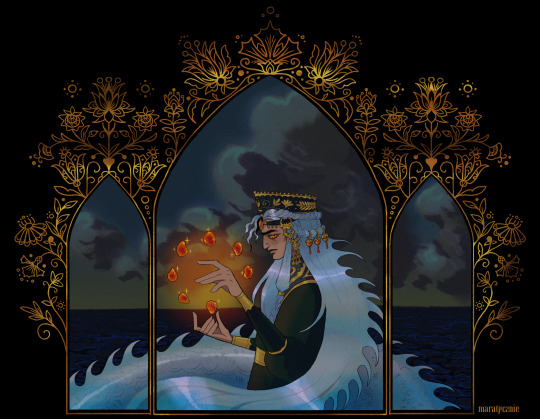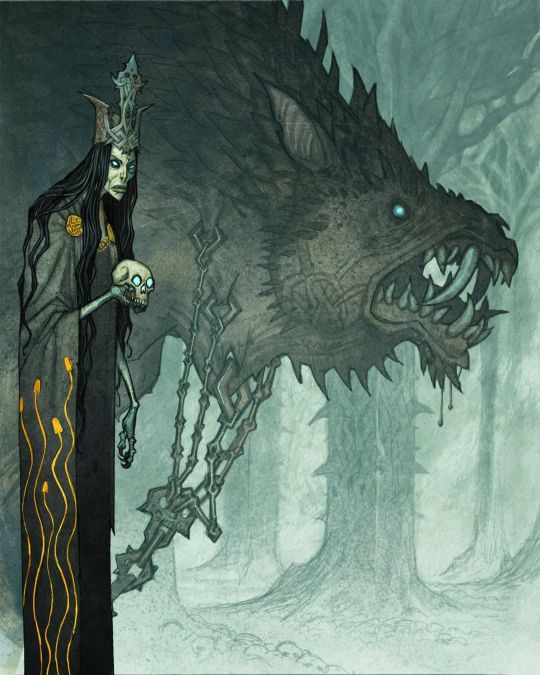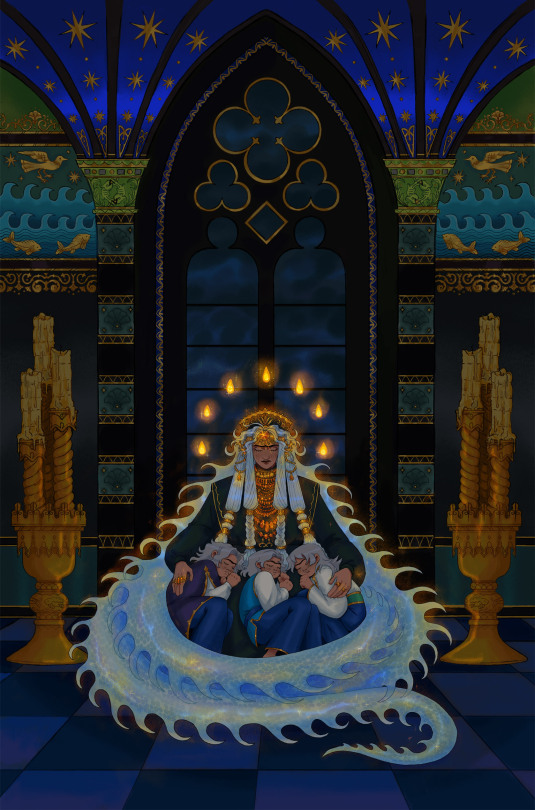#the last żmij
Text

My oc Damroka - The Last Żmij
26 notes
·
View notes
Text
Guardians of The Underworld
Cerberus
“Cerberus – also known as the “hound of Hades” – was the multi-headed dog who guarded the gates of the Underworld, preventing the dead from leaving, and making sure that those who entered never left. A child of Typhon and Echidna, he was part of a monstrous family, which included Orthus, the Lernaean Hydra, and the Chimaera as well. Only on three occasions Cerberus was tricked by visitors of Hades: Heracles did it with his strength, Orpheus with his music, and the Sybil of Cumae with a honey-cake.”
“Descriptions of Cerberus vary, including the number of his heads. Cerberus was usually three-headed, though not always. Cerberus had several multi-headed relatives. His father was the multi snake-headed Typhon, and Cerberus was the brother of three other multi-headed monsters, the multi-snake-headed Lernaean Hydra; Orthrus, the two-headed dog who guarded the Cattle of Geryon; and the Chimera, who had three heads: that of a lion, a goat, and a snake. And, like these close relatives, Cerberus was, with only the rare iconographic exception, multi-headed.”

Zmey
“A Zmei Gorynich or zmey and byliny (Russian epic poetry), is a dragon or serpent, or sometimes a human-like character with dragon-like traits.
“The word zmei in Russian is the masculine forms of zmeya, a feminine noun, meaning "snake".”
“The dragon in Russian folk fiction may be female, in which case she is called zmeya. The tendency is for the prose folktale versions to have male dragons, and the byliny poetry to have the females. This will affect the behavior of the dragons. For instance, only the male dragons will capture or captivate a princess or a maiden as a love interest.”
“The zmei is often depicted with multiple heads, and the number of heads may be 3, 6, 9, or 12. A three-, six-, nine-, and twelve-headed dragon are defeated on successive nights by the hero of the tale "Ivan the Peasant's Son and the Little Man the Size of a Finger". The twelve-headed one was hardest to kill, and although the hero beheaded it nearly completely, the last head had to be taken by six men provided to Ivan by the Tsar.”
“A Slavic dragon is any dragon in Slavic mythology, including the Russian zmei, known in Ukraine as zmiy, and its counterparts in other Slavic cultures: the Bulgarian zmei, the Slovak drak and šarkan, Czech drak, Polish żmij, the Serbian and Croatian zmaj, the Macedonian zmey. The Romanian zmeu is also a Slavic dragon, but a non-cognate etymology has been proposed.
A zmei may be beast-like or human-like, sometimes wooing women, but often plays the role of chief antagonist in Russian literature. In the Balkans, the zmei type is overall regarded as benevolent, as opposed to malevolent dragons known variously as lamia, ala or hala, or aždaja.
The Polish smok (e.g. Wawel Dragon of Kraków) or the Ukrainian or Belarusian smok, can also be included. In some Slavic traditions smok is an ordinary snake which may turn into a dragon with age.
Some of the common motifs concerning Slavic dragons include their identification as masters of weather or water source; that they start life as snakes; and that both the male and female can be romantically involved with humans.”

Garmr
“In Norse mythology, Garmr or Garm (Old Norse "rag”) is a wolf or dog associated with both Hel and Ragnarök, and described as a blood-stained guardian of Hel's gate.”
“In Norse Mythology, Garm is a giant wolf, or the “greatest of dogs” in the eddic poem Grimsnisal. He makes his most dramatic appearance in the gods’ end of the world, Ragnarok, where he is left tied up and howling. Snorri Sturlson pits him against the god Tyr in the great battle.
Mythology being what it is, Garm, Hel’s hound (as in Loki’s daughter Hel), and Fenrir all get a bit mixed up at times depending on whose version of the stories you read. This, of course, totally justifies my reasoning to use “Garm” as the name of my wolf shapeshifter guardians in the Nine World. (I wrote that last sentence with my tongue firmly in my cheek… ) Fenrir, however, is a lot better defined in Norse myth and thus kept his identity in my books.”

To be honest when I only started looking into this Knew both Greek and Norse mythologies had guard dogs for the underworld and I thought Zmey the dragon stood out a lot but as soon as I searched up Zmey and had a look at pictures and how he’s depicted I realised he had three heads just like Cerberus. I found this overlap really interesting as now two mythologies had guardians with 3 heads and it really seems like a pattern. Now I feel that Cerberus is the perfect mix of the two other mythologies turning the wold and three headed dragon into a three headed dog.
https://en.wikipedia.org/wiki/Garmr
http://www.loridevoti.com/fenrir-garm-wolves-norse-myth/?doing_wp_cron=1600937334.8865990638732910156250
https://www.greekmythology.com/Myths/Creatures/Cerberus/cerberus.html
https://en.wikipedia.org/wiki/Cerberus
https://en.wikipedia.org/wiki/Zmei_(Russian)
https://en.wikipedia.org/wiki/Slavic_dragon
5 notes
·
View notes
Note
Hello!! Long time follower! I am from the US mid-west, where there are many americans of Polish descent. An intern at my mother's school, who is from Poland, told her that the original spelling of my family's last name, Szczesny, means "lucky one" in polish. Is this true? If true, are there any uniquely polish symbols for luck? Thank you I love love love your blog!
Hello there and thank you for those kind words! ♥
I looked around for the meaning of the adjective ‘szczęsny’ (it’s not in regular use in the modern Polish language anymore) and I can confirm that in the old-Polish that word meant fortunate / lucky.
It’s closely related to the modern adjective ‘szczęśliwy’ which has a spectrum of meanings and depending on a context it can be translated to English as lucky or happy / joyful. I’d say it describes a mental feeling of luck and happiness.
Some sources say ‘szczęsny’ and ‘szczęśliwy’ are the same (only old vs modern Polish).
Both of them came from the noun ‘szczęście‘ that can also mean either luck or happiness (or both). A phrase ‘mieć szczęście’ means precisely ‘to have luck’, or ‘to be lucky’. Its etymology is the proto-Slavic sъčęstьje that meant happiness.
I had to think for a while about any unique symbols of luck in Poland. Most of them are universal (known worldwide or across all Slavic countries / eastern Europe). We cherish symbols like the horseshoe, four-leaf clover, rabbit’s foot, wishbone, cheemney sweeper (in my region after seeing the cheemney sweeper you have to grab a button and see a person in glasses within a few minutes while holding the button in order to grant the luck).
Something I’ve been told is a bit more unique is a stork that is bringing luck in the Polish and Slavic folklore.
A swallow can also bring luck, and the person who saw the first swallow arriving in spring was granted luck for the rest of the year. House which was chosen by a swallow to make a nest under its roof was predicted to have luck as well.
In folklore of many Polish regions gray or white cats were bringing luck.
To bring happiness and prosperity into the farm the rural people were making ‘the first spring blessing of cattle’ ceremonies and in them a cow in a wreath made of flowers and herbs was bringing the luck for the entire farm.
Many behaviours of the horses were bringing the luck. In general, horses were among the most sacred animals in old-Slavic beliefs and their behaviour was used in divinations. I think the beliefs about the horseshoes are connected to it in the particular example of Poland and other Slavic countries. A horseshoe was often burried under the foundation or tresholds of a new house to bring luck into it in the future. You can find many really cute designs of horses upon looking for a ‘konik ludowy’ (’folk horse’ in Polish), at least in the Polish google.
Some types of serpents native to Polish lands were bringing luck into the households, and they were believed to have their own serpent king (adder / viper king) - killing him was a doomed fate and its killer could’ve been excluded from the community. According to ethnographic sources there were regions in Poland where serpents were sacred animals and even kept in households, meant to protect from evil spells and bring the luck. In old legends and folklore a viper (żmija) was associated with a good land dragon (żmij) that in turn was associated with the Slavic god Weles / Veles.
A popular symbol bringing luck from the legends is the fern flower.
Houses were decorated with wycinanki - the decorative papercuts - and those had a whole range of purposes including protection but also bringing luck and happiness into the house. Many decorative pisanki (Easter eggs) were also meant to bring luck.
If you’re really looking for uniquely Polish symbols I suggest you can totally use some wycinanki for the luck. You can sometimes find a design with horses or storks and something like the one below would look great with swallows too [x]:

Here I have to also mention that many of such decorative, colorful flowers in the Polish wycinanki are sometimes interpreted as symbolizing the luck-bringing fern flower.
If you want a special amulet, a luck-bringing protective amulet from old Polish / Slavic folklore was a nawęza (simplified English spelling: nah-ven-zah). To make a nawęza you have to find either a small stone (the best is flat), a bone part, a fossil, a shell or a piece of wood that has already a ‘natural-made’ hole in it. Nawęzy are worn around the neck on a thin leather strap, or inside small pouches made of linen or wool that can be embroidered.
These are only a few examples, let me know if you want to know more :)
#gorgosgorgos#reply post#etymology#luck#symbols#symbole#nawęza#stork#swallow#cats#horses#cows#serpents#vipers#adders#żmij#weles#veles#fern flower#wycinanki
108 notes
·
View notes
Note
Jarilo, Mokosh, Żmij (because dragons :3)
Jarilo: the spring came and with it the memories - which spring do you remember best and why?
Hmmmmmm I think I have much more summer memories... I definitely remember last year’s spring, 5th of April to be exact (I know because I took photos to commemorate it, I checked just now)
I woke up that day and it was the first day that really felt like spring. I looked outside my room, into our garden and I just knew. The spring came. On my way to my classes, I just felt the world waking up. I felt the universe’s energy within me. I know this might sound cheesy, but that morning I really felt that I’m alive. (But when I told my friends they were all like “aw you’re cute” but I was like “BUT THE UNIVERSE!!! CAN’T YOU FEEL IT???)
Mokosh: a plant grows on your grave after you die, carrying a piece of your soul - what plant would it be?
A birch. I already decided. I’m gonna be buried under a birch tree and if I’m not I’m gonna haunt my relatives.
Żmij: you see before you a creature of hundred eyes and sly smiles - do you banish it or befriend it?
I’ll... try to befriend it??? because if you banish it you’re just gonna make the creature furious??? why would you want that???? the sly smiles part is suspicious but ??? it’s better than having a monster have a grudge against you???
2 notes
·
View notes
Text

"Goodbye my sons"
40 notes
·
View notes
Text

"Their hair is silver like waves of the sea,
Their eyes like jantars found in the depths"
Jaromir, Wisław and Sambor - Three Princes of Pomerania, by their mother's blood, they are partially żmije, serpent-like creatures similar to dragons.
Their mother was last of her kind, an old and powerful żmij of golden tears of Sun and cold waters of the Sea.
#the last żmij#original character#oc#my art#slavic folklore#pomeranian#pomorze#kaszuby#fantasy#character design
25 notes
·
View notes